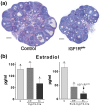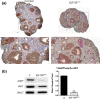IGF1R Expression in Ovarian Granulosa Cells Is Essential for Steroidogenesis, Follicle Survival, and Fertility in Female Mice
- PMID: 28407051
- PMCID: PMC5505221
- DOI: 10.1210/en.2017-00146
IGF1R Expression in Ovarian Granulosa Cells Is Essential for Steroidogenesis, Follicle Survival, and Fertility in Female Mice
Abstract
Folliculogenesis is a lengthy process that requires the proliferation and differentiation of granulosa cells (GCs) for preovulatory follicle formation. The most crucial endocrine factor involved in this process is follicle-stimulating hormone (FSH). Interestingly, previous in vitro studies indicated that FSH does not stimulate GC proliferation in the absence of the insulinlike growth factor 1 receptor (IGF1R). To determine the role of the IGF1R in vivo, female mice with a conditional knockdown of the IGF1R in the GCs were produced and had undetectable levels of IGF1R mRNA and protein in the GCs. These animals were sterile, and their ovaries were smaller than those of control animals and contained no antral follicles even after gonadotropin stimulation. The lack of antral follicles correlated with a 90% decrease in serum estradiol levels. In addition, under a superovulation protocol no oocytes were found in the oviducts of these animals. Accordingly, the GCs of the mutant females expressed significantly lower levels of preovulatory markers including aromatase, luteinizing hormone receptor, and inhibin α. In contrast, no alterations in FSH receptor expression were observed in GCs lacking IGF1R. Immunohistochemistry studies demonstrated that ovaries lacking IGF1R had higher levels of apoptosis in follicles from the primary to the large secondary stages. Finally, molecular studies determined that protein kinase B activation was significantly impaired in mutant females when compared with controls. These in vivo findings demonstrate that IGF1R has a crucial role in GC function and, consequently, in female fertility.
Copyright © 2017 Endocrine Society.
Figures






Comment in
-
Female Fertility: It Takes Two to Tango.Endocrinology. 2017 Jul 1;158(7):2074-2076. doi: 10.1210/en.2017-00447. Endocrinology. 2017. PMID: 28881869 Free PMC article. No abstract available.
References
-
- Chandra A, Martinez GM, Mosher WD, Abma JC, Jones J. Fertility, family planning, and reproductive health of U.S. women: data from the 2002 National Survey of Family Growth. Vital and Health Statistics Series 23. Hyattsville, MD: Centers for Disease Control and Prevention, National Center for Health Statistics; 2005:1–160. - PubMed
-
- Li RH, Ng EH. Management of anovulatory infertility. Best Pract Res Clin Obstet Gynaecol. 2012;26(6):757–768. - PubMed
-
- Kumar TR, Wang Y, Lu N, Matzuk MM. Follicle stimulating hormone is required for ovarian follicle maturation but not male fertility. Nat Genet. 1997;15(2):201–204. - PubMed
Publication types
MeSH terms
Substances
Grants and funding
LinkOut - more resources
Full Text Sources
Other Literature Sources
Molecular Biology Databases
Miscellaneous

